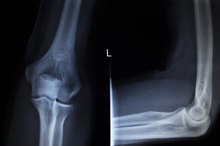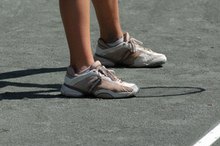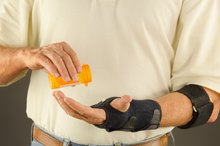Pain and Swelling in the Shoulders, Arms and Hands
Pain and swelling in your shoulders, arms and hands could be a symptom of a variety of conditions, including arthritis, a traumatic injury or an illness. Your doctor will make a diagnosis based on your gender, age and a more in-depth examination of your symptoms. For example, swelling in your joints could be a type of arthritis, while swelling in your muscles could be from a strain or injury.
Sternoclavicular Joint Dislocation
A traumatic fall or blow to your shoulder can cause sternoclavicular joint dislocation, a condition that causes pain, swelling and tingling in the shoulder, arm and hand. The sternoclavicular joint is in the shoulder and is partly responsible for mobility between the shoulder and trunk. In 2008, the “Canadian Journal of Surgery” published a report indicating that because sternoclavicular joint dislocation is uncommon, it often goes misdiagnosed. Depending on the exact location of the injury, complications include respiratory problems, vascular injuries, nerve damage, problems swallowing and even death.
- A traumatic fall or blow to your shoulder can cause sternoclavicular joint dislocation, a condition that causes pain, swelling and tingling in the shoulder, arm and hand.
Carpal Tunnel Syndrome
Torn Tendons & Ligaments From Hyperextension
Learn More
The carpal tunnel is a pathway in the wrist containing nerves that control hand movement and sensation. Repetitive stress to the nerve, which runs from the inner wrist to the forearm, can cause carpal tunnel syndrome. Irritated tendons can also thicken or swell in the carpal tunnel and press on the median nerve. Symptoms include pain and swelling that radiates between the shoulder and hand as well as burning, tingling, itching and numbness. Symptoms can occur in one or both hands. Medical conditions such as an overactive pituitary gland, hypothyroidism and rheumatoid arthritis can also cause carpal tunnel syndrome.
- The carpal tunnel is a pathway in the wrist containing nerves that control hand movement and sensation.
- Irritated tendons can also thicken or swell in the carpal tunnel and press on the median nerve.
Complex Regional Pain Syndrome
Complex regional pain syndrome, or CRPS, is a chronic pain disorder that typically affects the limbs. CRPS is characterized by intense burning or aching pain and swelling in the arm or hand, joint stiffness, muscle spasms and weakness. Other symptoms include skin discoloration, changes in temperature, sweating and sensitivity in the affected areas. CRPS often follows an injury or illness.
- Complex regional pain syndrome, or CRPS, is a chronic pain disorder that typically affects the limbs.
- CRPS is characterized by intense burning or aching pain and swelling in the arm or hand, joint stiffness, muscle spasms and weakness.
Treatment
Causes of Arm Pain Between the Wrist and Elbow
Learn More
If your symptoms are mild, you can treat pain and reduce swelling with over-the-counter anti-inflammatory medications like ibuprofen or aspirin. Applying a cold compress or ice can relieve swelling, and heat can ease tight muscles and spasms. If your pain and swelling is unmanageable or if it persists longer than a few days, call your doctor.
Related Articles
References
- HealthCentral.com: Sternoclavicular Joint Dislocation
- Canadian Journal of Surgery: Posterior Sternoclavicular Joint Dislocation; Nathan Hoekzema, et al.; February 2008
- MedlinePlus: Complex Regional Pain Syndrome
- National Institute of Neurological Disorders and Stroke. Carpal Tunnel Syndrome Fact Sheet. Updated April 7, 2020.
- American Academy of Orthopaedic Surgeons. OrthoInfo. Carpal Tunnel Syndrome.
- Kaiser MG, Haid RW, Shaffrey CI, Fehlings MG. Degenerative Cervical Myelopathy and Radiculopathy Treatment Approaches and Options. New York, NY: Springer International Publishing; 2018.
- Cleveland Clinic. HealthEssentials. Why Cubital Tunnel Syndrome Is No Laughing Matter. April 12, 2019.
- Hultman CS. The carpal-tunnel syndrome. Seventeen years’ experience in diagnosis and treatment of six hundred fifty-four hands. In 50 Studies Every Plastic Surgeon Should Know. Boca Raton, FL: CRC Press; 2014.
Writer Bio
Shannon Marks started her journalism career in 1994. She was a reporter at the "Beachcomber" in Rehoboth Beach, Del., and contributed to "Philadelphia Weekly." Marks also served as a research editor, reporter and contributing writer at lifestyle, travel and entertainment magazines in New York City. She holds a Bachelor of Arts in literature from Temple University.








